It looks like you're using an Ad Blocker.
Please white-list or disable AboveTopSecret.com in your ad-blocking tool.
Thank you.
Some features of ATS will be disabled while you continue to use an ad-blocker.
share:
Many times here on ATS we see the same question brought up: "Why can't the Hubble Space Telescope see (insert object here) in detail?"
It's a good question to ask if you do not know a lot about telescopes and optics in general.
Many have pointed out the beautiful, detailed images that Hubble takes of say Orion's Nebula or another galaxy, but wonder why it cannot see detailed images of say, the surface of Mars, or the surface of Pluto.
Hubble Image Of Orion's Nebula:
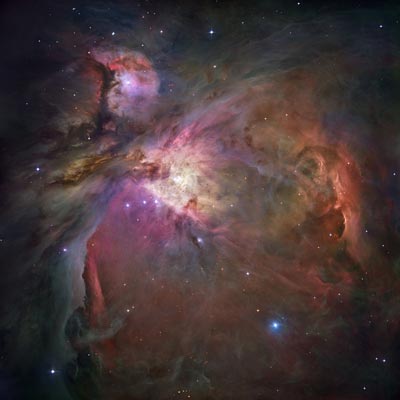
Hubble Image Of Mars:

Hubble Image Of Pluto that's been computer enhanced.
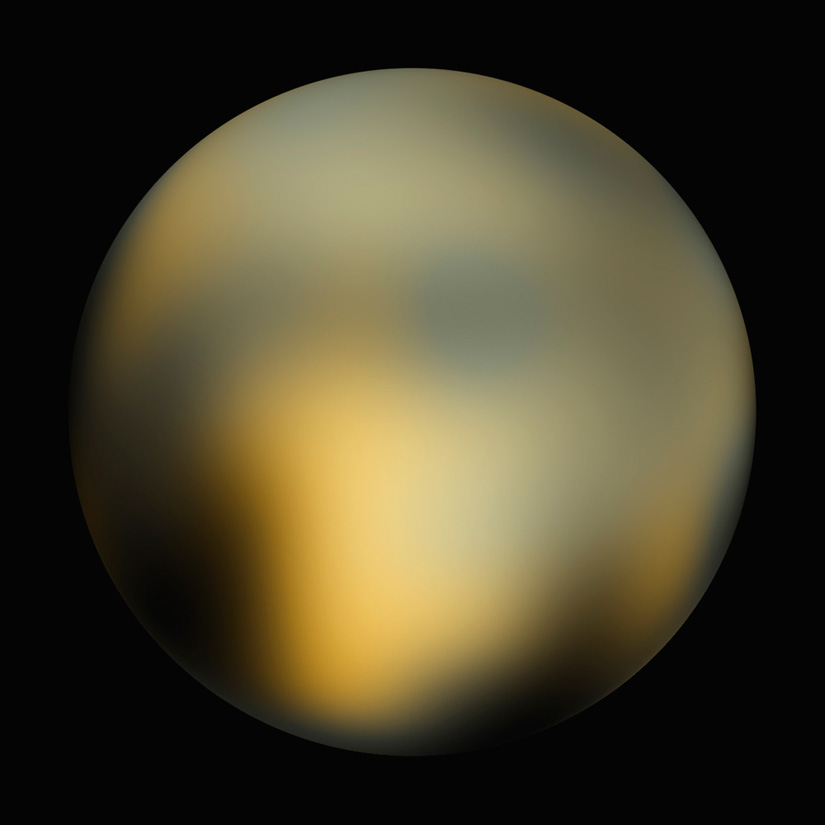
The answer to this question has two parts to it. The reasons are: Angular Resolution and Size / Distance of the Object.
Let's take a look at Angular Resolution, to see what it is.
Angular Resolution is the ability of an imaging device (telescope, camera, microscope, your eye) to be able to resolve the detail of another object.
Angular Resolution is normally measured in Arc Seconds.
To give you an idea of what an Arc Second is: Look at our sky. If you measure your horizon from East to West (or North to South), you have 180 degrees of sky.
1 degree = 60 arc minutes. Or 1 degree = 3600 arcseconds
The full moon in the sky covers about 1/2 a degree, or 1800 arc seconds.
The way we find Angular Resolution is by dividing the wavelength of the light emitted (or reflected) off an object by the diameter of the aperture of the imaging device. For a telescope we use something called
Dawes' Limit, which is basically a formula for finding out the resolving power of a telescope.
Basically it is R=4.56/D where R is Arcseconds, and D is the diameter of the aperture in inches.
For metric you use R=11.6/D where D is the diameter of the aperture in centimeters.
The human eye has a resolution of about 60 arcseconds. This is why we can see the full moon quite clearly since it covers 1,800 arcseconds and why we can even make out features on its surface with just our eyes.
But now this is where the second part of this discussion takes over: Size / Distance of that object.
Both cars in this image have the same width, but the one further away has a smaller Angular Diameter:
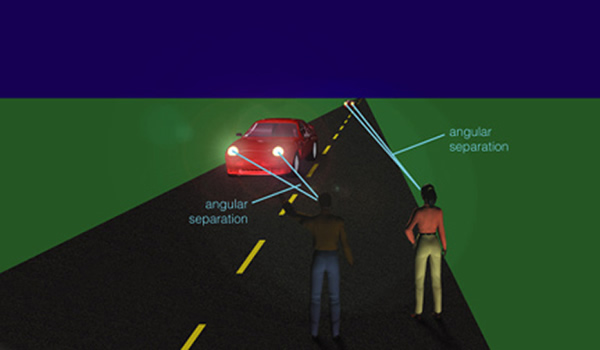
The Moon's diameter is 3476 kilometers. Its average distance from us is 384,000 kilometers. As I said above, a full moon covers about 1/2 a degree of our sky, or 1,800 arcseconds. Knowing this, and knowing both the size and distance of the moon, we can figure out what the smallest detail on the moon is that your eyes can see:
Take the diameter of the moon, 3476 km, and divide it by the amount of arcseconds a full moon covers, 1800 arcseconds, and you get 1.93, which is how many arcseconds 1 km is when seeing the moon from the Earth's surface. Now multiply that by the resolution of your eyeball, which is 60 arcseconds, and that means the smallest object your naked eye can see on the moon's surface is: 115.86 km wide.
So as you can see, it's not only the size of the aperture that matters, but also how big an object is AND how far away it is.
Hubble's primary mirror is 2.4 meters in diameter, or 240 centimeters. Using Dawes' Limit, that means it has an angular resolution of 0.05 arcseconds. Much better than our eyeballs of course.
But how does that stack up to seeing something on the Moon with Hubble? Again, all we have to do is the math. We already determined that due to the Moon's size and distance, 1.93 kilometers is how big 1 arcsecond is (but again, that's based on the Moon's size and distance). Multiply Hubble's Angular Resolution to 1.93, and we get:
0.965 km.
So even as powerful as Hubble's Angular Resolution is, it can still only see something as just under a kilometer in size on the Moon using the Hubble Space Telescope.
Hubble Image of Tycho Crater On The Moon:
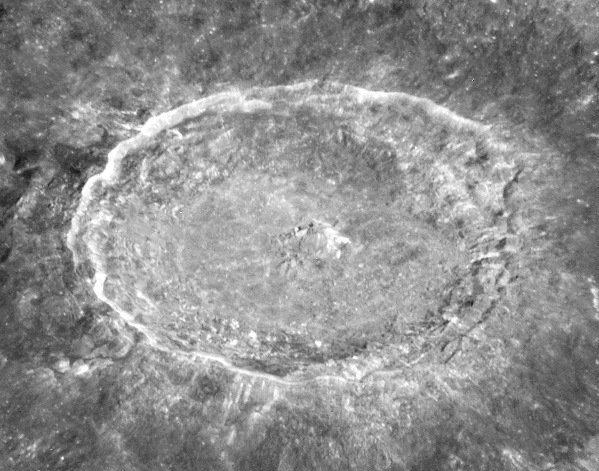
Picture provided by ATS member Saint Exupery, as the picture I had was wrong.
What about Mars?
Well, to find that out, you already have Hubble's Angular Resolution: 0.05 arcseconds. So now you only need to find out how much sky Mars covers.
Mars' diameter is 6792 km. The closest it gets to Earth is 54.6 million kilometers. That means that Mars takes up 25.08 arcseconds in our skies when it is as close as it can get to us. Now you know why it only looks like a orange point of light to just your eyeball, because its angular diameter even at its closest distance is too small to make out any details at all using just your unaided eye.
Let's have Hubble look at it with its Angular Resolution of 0.05 arc seconds. First, how many kilometers is an arcsecond for Mars? Based upon the numbers we have, when Mars is at its closest to Earth, 1 arcsecond is 270.81 kilometers. So that means Hubble can only see things that are at least 13.54 kilometers big on the surface of Mars.
That's actually pretty good considering how small Mars is and how far away it is. What about a telescope you might own?
Let's go big and say you have a 25.4 centimeter telescope (10 inch reflector). The Angular Resolution of a telescope that big is 0.45 arcseconds. So, not as good as Hubble (not to mention you're at the mercy of the Earth's atmosphere, etc).
But that means that with your home telescope, the biggest object you can see in detail on Mars would be 121.86 kilometers.
So what about Pluto?
Pluto's Angular Diameter when it's closest to Earth is only 0.115 arcseconds. That's small. VERY small! With a diameter of only 2368 kilometers and the closest it gets to Earth being 2.66 BILLION miles, that's very small, and very far away. So it's no wonder its largest angular diameter is only 0.115 arcseconds.
So....what's the biggest thing Hubble can see on Pluto?
2368 km / 0.115 arcseconds = 20594 km. That's how big 1 arc second is looking at the distance of Pluto and its size. So:
20594 km x 0.05 arcseconds = 1029.56 km. That's almost half the size of the planet itself!
So, as you can see, even as powerful as Hubble is with its Angular Resolution, Pluto is just too small and at such a great distance for Hubble to make out anything of real detail.
So why can Hubble give us such detailed images of say, the Andromeda Galaxy? It's around 2.5 million light-years away!
Hubble Image Of Andromeda:
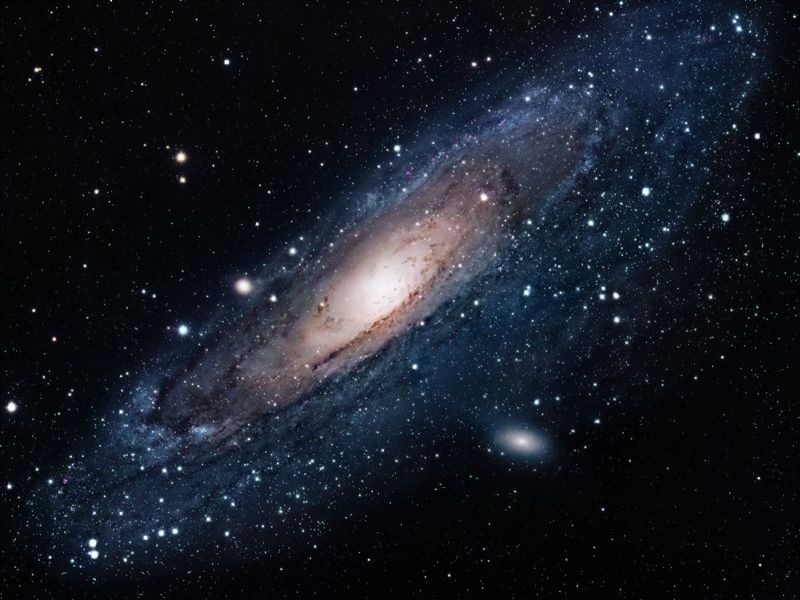
Yes, it is that far away. But it's big. Very big! It's 220,000 light-years wide! As a matter of fact, its angular diameter in our sky is 3 degrees! It's actually 6 times bigger in our sky than the full moon!
So now you know: the reason that Hubble can show us great detail of objects much further away such as nebulae and galaxies compared to the planets in our own solar system, is because those objects are huge. Their details are huge compared to planets (even Jupiter), which are much smaller than they are. The smaller the object is and the further away it is, the harder it is to see the detail of it.
It's a good question to ask if you do not know a lot about telescopes and optics in general.
Many have pointed out the beautiful, detailed images that Hubble takes of say Orion's Nebula or another galaxy, but wonder why it cannot see detailed images of say, the surface of Mars, or the surface of Pluto.
Hubble Image Of Orion's Nebula:

Hubble Image Of Mars:

Hubble Image Of Pluto that's been computer enhanced.

The answer to this question has two parts to it. The reasons are: Angular Resolution and Size / Distance of the Object.
Let's take a look at Angular Resolution, to see what it is.
Angular Resolution is the ability of an imaging device (telescope, camera, microscope, your eye) to be able to resolve the detail of another object.
Angular Resolution is normally measured in Arc Seconds.
To give you an idea of what an Arc Second is: Look at our sky. If you measure your horizon from East to West (or North to South), you have 180 degrees of sky.
1 degree = 60 arc minutes. Or 1 degree = 3600 arcseconds
The full moon in the sky covers about 1/2 a degree, or 1800 arc seconds.
The way we find Angular Resolution is by dividing the wavelength of the light emitted (or reflected) off an object by the diameter of the aperture of the imaging device. For a telescope we use something called
Dawes' Limit, which is basically a formula for finding out the resolving power of a telescope.
Basically it is R=4.56/D where R is Arcseconds, and D is the diameter of the aperture in inches.
For metric you use R=11.6/D where D is the diameter of the aperture in centimeters.
The human eye has a resolution of about 60 arcseconds. This is why we can see the full moon quite clearly since it covers 1,800 arcseconds and why we can even make out features on its surface with just our eyes.
But now this is where the second part of this discussion takes over: Size / Distance of that object.
Both cars in this image have the same width, but the one further away has a smaller Angular Diameter:

The Moon's diameter is 3476 kilometers. Its average distance from us is 384,000 kilometers. As I said above, a full moon covers about 1/2 a degree of our sky, or 1,800 arcseconds. Knowing this, and knowing both the size and distance of the moon, we can figure out what the smallest detail on the moon is that your eyes can see:
Take the diameter of the moon, 3476 km, and divide it by the amount of arcseconds a full moon covers, 1800 arcseconds, and you get 1.93, which is how many arcseconds 1 km is when seeing the moon from the Earth's surface. Now multiply that by the resolution of your eyeball, which is 60 arcseconds, and that means the smallest object your naked eye can see on the moon's surface is: 115.86 km wide.
So as you can see, it's not only the size of the aperture that matters, but also how big an object is AND how far away it is.
Hubble's primary mirror is 2.4 meters in diameter, or 240 centimeters. Using Dawes' Limit, that means it has an angular resolution of 0.05 arcseconds. Much better than our eyeballs of course.
But how does that stack up to seeing something on the Moon with Hubble? Again, all we have to do is the math. We already determined that due to the Moon's size and distance, 1.93 kilometers is how big 1 arcsecond is (but again, that's based on the Moon's size and distance). Multiply Hubble's Angular Resolution to 1.93, and we get:
0.965 km.
So even as powerful as Hubble's Angular Resolution is, it can still only see something as just under a kilometer in size on the Moon using the Hubble Space Telescope.
Hubble Image of Tycho Crater On The Moon:

Picture provided by ATS member Saint Exupery, as the picture I had was wrong.
What about Mars?
Well, to find that out, you already have Hubble's Angular Resolution: 0.05 arcseconds. So now you only need to find out how much sky Mars covers.
Mars' diameter is 6792 km. The closest it gets to Earth is 54.6 million kilometers. That means that Mars takes up 25.08 arcseconds in our skies when it is as close as it can get to us. Now you know why it only looks like a orange point of light to just your eyeball, because its angular diameter even at its closest distance is too small to make out any details at all using just your unaided eye.
Let's have Hubble look at it with its Angular Resolution of 0.05 arc seconds. First, how many kilometers is an arcsecond for Mars? Based upon the numbers we have, when Mars is at its closest to Earth, 1 arcsecond is 270.81 kilometers. So that means Hubble can only see things that are at least 13.54 kilometers big on the surface of Mars.
That's actually pretty good considering how small Mars is and how far away it is. What about a telescope you might own?
Let's go big and say you have a 25.4 centimeter telescope (10 inch reflector). The Angular Resolution of a telescope that big is 0.45 arcseconds. So, not as good as Hubble (not to mention you're at the mercy of the Earth's atmosphere, etc).
But that means that with your home telescope, the biggest object you can see in detail on Mars would be 121.86 kilometers.
So what about Pluto?
Pluto's Angular Diameter when it's closest to Earth is only 0.115 arcseconds. That's small. VERY small! With a diameter of only 2368 kilometers and the closest it gets to Earth being 2.66 BILLION miles, that's very small, and very far away. So it's no wonder its largest angular diameter is only 0.115 arcseconds.
So....what's the biggest thing Hubble can see on Pluto?
2368 km / 0.115 arcseconds = 20594 km. That's how big 1 arc second is looking at the distance of Pluto and its size. So:
20594 km x 0.05 arcseconds = 1029.56 km. That's almost half the size of the planet itself!
So, as you can see, even as powerful as Hubble is with its Angular Resolution, Pluto is just too small and at such a great distance for Hubble to make out anything of real detail.
So why can Hubble give us such detailed images of say, the Andromeda Galaxy? It's around 2.5 million light-years away!
Hubble Image Of Andromeda:

Yes, it is that far away. But it's big. Very big! It's 220,000 light-years wide! As a matter of fact, its angular diameter in our sky is 3 degrees! It's actually 6 times bigger in our sky than the full moon!
So now you know: the reason that Hubble can show us great detail of objects much further away such as nebulae and galaxies compared to the planets in our own solar system, is because those objects are huge. Their details are huge compared to planets (even Jupiter), which are much smaller than they are. The smaller the object is and the further away it is, the harder it is to see the detail of it.
edit on 6/25/2015 by eriktheawful because: Corrections made on errors pointed out by other members
edit on 6/25/2015 by
eriktheawful because: (no reason given)
a reply to: eriktheawful
Nicely said!
Science is fun.
S&F
On a not-so-unrelated topic: Hubble takes black-and-white pictures, colour is actually artificially added. Alot of editing goes in for contrast and noise, too.
hubblesite.org...
This is to say that artefacts can sometimes appear - these artefacts are NOT alien spaceships, no matter how hard you zoom on the poor anomalous pixels.
Nicely said!
Science is fun.
S&F
On a not-so-unrelated topic: Hubble takes black-and-white pictures, colour is actually artificially added. Alot of editing goes in for contrast and noise, too.
hubblesite.org...
This is to say that artefacts can sometimes appear - these artefacts are NOT alien spaceships, no matter how hard you zoom on the poor anomalous pixels.
edit on 25-6-2015 by swanne because: (no reason given)
Space is big. You just won't believe how vastly, hugely, mind-bogglingly big it is. I mean, you may think it's a long way down the road to the chemist's, but that's just peanuts to space.
Hitchhiker's Guide
edit on 6/25/2015 by Zaphod58 because: (no reason given)
its a spacestation
an intelligently crafted object
top secret
an intelligently crafted object
top secret
originally posted by: blacktie
a reply to: Zaphod58
moons and various other locations
The Moon and "various other locations" are "intelligently crafted objects"?!
Any evidences to support the claim that some alien built a "spacecraft" weighting some million trillions tons, and what kind of fuel they used to accelerate it into orbit around Earth?
edit on 25-6-2015 by swanne because: (no reason given)
a reply to: eriktheawful
Very nicely written, sir. I have never paid attention to the math, but I knew the underlying "why." Thanks for the additional info!
Very nicely written, sir. I have never paid attention to the math, but I knew the underlying "why." Thanks for the additional info!
Wait. Please.
The subject of the thread is about being able to see details due to a device's angular resolution, size of the object and distance.
Could we please keep it on that? As really interesting as a debate on whether or not what we see is natural or artificial is, it's really off topic and should have it's own thread for discussion.
I'd be happy to answer any other questions about this thread topic however.
The subject of the thread is about being able to see details due to a device's angular resolution, size of the object and distance.
Could we please keep it on that? As really interesting as a debate on whether or not what we see is natural or artificial is, it's really off topic and should have it's own thread for discussion.
I'd be happy to answer any other questions about this thread topic however.
I like your piece... (I actually need to read it again, as I just skimmed it during a break I'm taking from weed-whacking my mom's back yard/overgrown
field.)
Something I did get from your post (if I got it right) is that it CAN focus on the moon, albeit 1 km at a time. I do believe space is our future, but the moon is probably that one small step before the giant leap that is our outer space travels... So why don't we go ahead and devote the Hubble, or at least a year, to understanding our closest neighbor? (It could be that we already know everything, but I doubt that's the case)
Things that make you go, "hmm..." I'll be back later tonight. Keep up the good work.
Something I did get from your post (if I got it right) is that it CAN focus on the moon, albeit 1 km at a time. I do believe space is our future, but the moon is probably that one small step before the giant leap that is our outer space travels... So why don't we go ahead and devote the Hubble, or at least a year, to understanding our closest neighbor? (It could be that we already know everything, but I doubt that's the case)
Things that make you go, "hmm..." I'll be back later tonight. Keep up the good work.
a reply to: japhrimu
Well, as I said, Hubble's angle of resolution for the Moon means anything under 1 km in size isn't going to show up too well.
However! A camera in orbit around the Moon can do much better! And we have one of those. It's call the LROC, and it's able to see things down to under 1/2 a meter big!
Here's one of the web sites dedicated to it, and the many place you can zoom in and you CAN see a 2 foot wide rock just fine!
LROC QuickMaps
Well, as I said, Hubble's angle of resolution for the Moon means anything under 1 km in size isn't going to show up too well.
However! A camera in orbit around the Moon can do much better! And we have one of those. It's call the LROC, and it's able to see things down to under 1/2 a meter big!
Here's one of the web sites dedicated to it, and the many place you can zoom in and you CAN see a 2 foot wide rock just fine!
LROC QuickMaps
originally posted by: eriktheawful
LROC QuickMaps
That's actually pretty impressive. The resolution is very good indeed.
a reply to: eriktheawful
Nice job explaining resolution and angular size. Hubble has it's limitations, even though it has produced the most impressive images ever taken of objects in the universe.
Hubble suffers from wave-front inaccuracy in the main mirror and an intermediate mirror was retrofitted to optically repair it. Because it was precisely inaccurate, it was fixable, however, the intermediate mirror applies aberration of it's own so Hubble's resolution is still not what it could be. The James Webb will soon replace it with some really stunning specs. They are talking about enhanced IR and the ability to resolve with an accuracy of 5 milliarcsec rms. (hope they get it right the first time!)
Nice job explaining resolution and angular size. Hubble has it's limitations, even though it has produced the most impressive images ever taken of objects in the universe.
Hubble suffers from wave-front inaccuracy in the main mirror and an intermediate mirror was retrofitted to optically repair it. Because it was precisely inaccurate, it was fixable, however, the intermediate mirror applies aberration of it's own so Hubble's resolution is still not what it could be. The James Webb will soon replace it with some really stunning specs. They are talking about enhanced IR and the ability to resolve with an accuracy of 5 milliarcsec rms. (hope they get it right the first time!)
edit on 25-6-2015 by charlyv because: s
Thankyou very much for taking the time out to explain this. Much needed.
originally posted by: eriktheawful
Hubble Image Of Pluto:
That image of Pluto you posted is not exactly a traditional image, and not what Hubble can actually resolve. That image of Pluto has been somewhat computer generated to show more pixels and more detail than Hubble is capable of capturing. They used a "dithering" technique and a bunch of lower resolution images to computer generate that image.
Here is a description of image dithering technique explained on the Hubble website:
The Hubble images are only a few pixels wide. But through a technique called dithering, multiple, slightly offset pictures can be combined through computer-image processing to synthesize a higher-resolution view than could be seen in a single exposure. "This has taken four years and 20 computers operating continuously and simultaneously to accomplish," says Buie, who developed special algorithms to sharpen the Hubble data.
edit on 6/25/2015 by Soylent Green Is People because: (no reason given)
new topics
-
God's Righteousness is Greater than Our Wrath
Religion, Faith, And Theology: 4 hours ago -
Electrical tricks for saving money
Education and Media: 7 hours ago -
VP's Secret Service agent brawls with other agents at Andrews
Mainstream News: 8 hours ago -
Sunak spinning the sickness figures
Other Current Events: 9 hours ago -
Nearly 70% Of Americans Want Talks To End War In Ukraine
Political Issues: 9 hours ago -
Late Night with the Devil - a really good unusual modern horror film.
Movies: 11 hours ago
top topics
-
VP's Secret Service agent brawls with other agents at Andrews
Mainstream News: 8 hours ago, 9 flags -
Cats Used as Live Bait to Train Ferocious Pitbulls in Illegal NYC Dogfighting
Social Issues and Civil Unrest: 12 hours ago, 8 flags -
Electrical tricks for saving money
Education and Media: 7 hours ago, 4 flags -
HORRIBLE !! Russian Soldier Drinking Own Urine To Survive In Battle
World War Three: 16 hours ago, 3 flags -
Nearly 70% Of Americans Want Talks To End War In Ukraine
Political Issues: 9 hours ago, 3 flags -
Sunak spinning the sickness figures
Other Current Events: 9 hours ago, 3 flags -
Late Night with the Devil - a really good unusual modern horror film.
Movies: 11 hours ago, 2 flags -
The Good News According to Jesus - Episode 1
Religion, Faith, And Theology: 14 hours ago, 1 flags -
God's Righteousness is Greater than Our Wrath
Religion, Faith, And Theology: 4 hours ago, 0 flags
active topics
-
God's Righteousness is Greater than Our Wrath
Religion, Faith, And Theology • 1 • : andy06shake -
SETI chief says US has no evidence for alien technology. 'And we never have'
Aliens and UFOs • 45 • : andy06shake -
Sunak spinning the sickness figures
Other Current Events • 7 • : xWorldxGonexMadx -
HORRIBLE !! Russian Soldier Drinking Own Urine To Survive In Battle
World War Three • 33 • : Degradation33 -
How ageing is" immune deficiency"
Medical Issues & Conspiracies • 34 • : angelchemuel -
Nearly 70% Of Americans Want Talks To End War In Ukraine
Political Issues • 13 • : Freeborn -
Mood Music Part VI
Music • 3101 • : ThatSmellsStrange -
VP's Secret Service agent brawls with other agents at Andrews
Mainstream News • 41 • : ThatSmellsStrange -
New whistleblower Jason Sands speaks on Twitter Spaces last night.
Aliens and UFOs • 55 • : baablacksheep1 -
Cats Used as Live Bait to Train Ferocious Pitbulls in Illegal NYC Dogfighting
Social Issues and Civil Unrest • 20 • : Asher47

